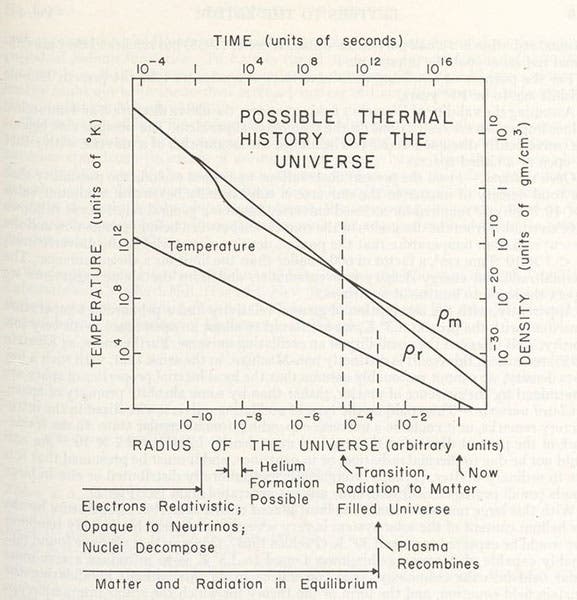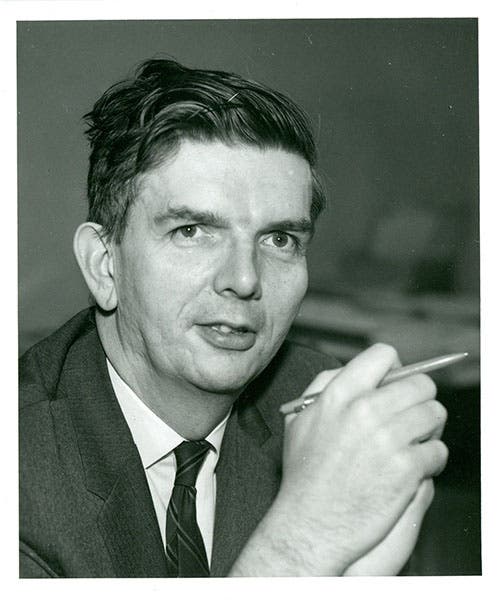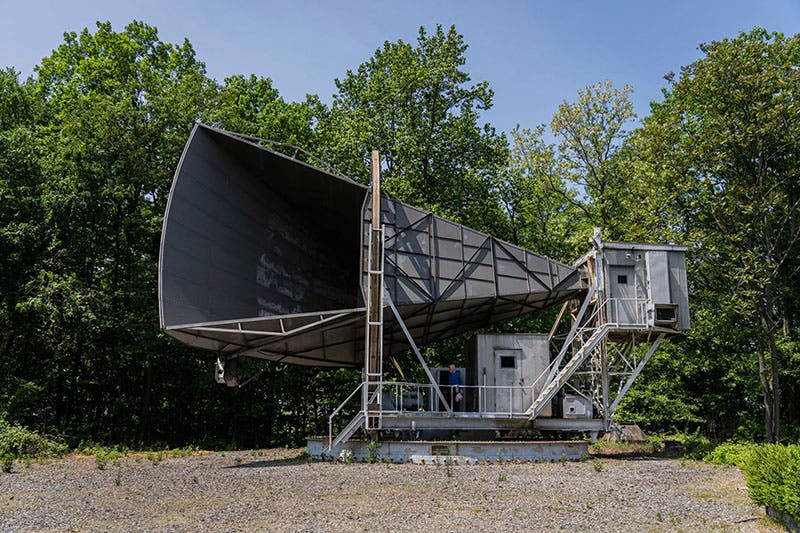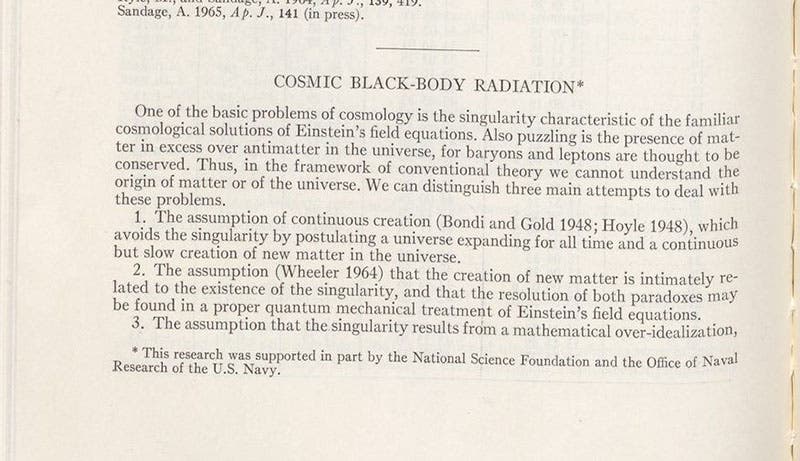Scientist of the Day - Robert Dicke
Robert Henry Dicke, an American physicist, was born May 6, 1916, in Saint Louis. He received his undergraduate degree in physics from Princeton and his PhD from Rochester. During the Second World War, he worked at the Radiation Lab at MIT. Dicke was unusual among physicists in that he was equally adept at experimental and theoretical physics. While at MIT, he invented a new kind of device that could search out very faint radio signals over the background noise; it came to be called a Dicke radiometer. It will play a role in our story.
Dicke began his post-war career as a professor at Princeton, and much of his career was devoted to testing the gravitational theory provided by general relativity. But in 1964, he became interested in an implication of the Big Bang theory, a cosmology that had been proposed by George Gamow, Ralph Alpher, and Robert Hermann in 1948. If the universe began at a temperature of billions of degrees, and has been expanding ever since, then there ought to be a residual temperature, a leftover from the Big Bang. Given the known rate of expansion, and changes in that rate, one ought to be able to calculate that temperature, and Dicke did so, arriving at a figure of around 5 degrees above absolute zero. Moreover, that calculation should be testable – one ought to be able to measure it. He assigned two of his students to the task of building a Dicke radiometer so they could look for that residual radiation, which should be in the microwave region of the spectrum
Dicke was not aware that, 30 miles away, a pair of Bell Lab engineers, Arno Penzias and Robert Wilson, were trying to improve the reception of a horn antenna in Holmdel, New Jersey (third image). The antenna had been used since 1960 for satellite communications, detecting microwaves that had been bounced off the new Echo satellite, and their job was to get rid of all the background noise that was obscuring the signals. Using a Dicke radiometer, they detected a background noise in the microwave region that they could not eradicate or explain. It came from all directions, even the emptiest regions of space, and it was not connected to the behavior of any solar system bodies. It had a wavelength characteristic of a body radiating energy at a temperature of 3° K (we would now say 3 kelvins, 3° above absolute zero). It was a mystery.
In December of 1964, while on a plane flight home from a conference, Penzias discussed his microwave noise with a fellow physicist, who suggested that he get in touch with Dicke and his team at Princeton. Penzias phoned up Dicke immediately and learned that the background radiation they had detected was probably the very same radiation that Dicke and his colleagues had predicted. Dicke went down to Holmdel, saw their results, and was probably gladdened and saddened at the same time. Had Dicke discovered the radiation himself, after predicting it, he would surely have been awarded a Noble prize. This was, after all, the first powerful evidence for a Big Bang. As it happened, Penzias and Wilson got the Nobel prize for discovering cosmic background radiation (in 1978), and Dicke never received a Nobel award. We have published posts on Penzias, and on Wilson.
Dicke and Penzias arranged for their papers to be published back-to-back in the July 1, 1965, issue of Astrophysical Journal, in the “Letters to the Editor” section at the very end. Dicke’s paper, “Cosmic black-body radiation,” came first, 5 pages long, dated May 7, and was followed by the Penzias-Wilson paper, “A measurement of excess antenna temperature at 4080 Mc/s”, just over a page long, and dated May 13. We include here the beginning and end of Dicke’s paper (fourth and fifth images), as well as a graphic (first image), showing the decline of the temperature of the cosmic radiation over time to its present 3.5 kelvins level, the temperature measured by Penzias and Wilson.
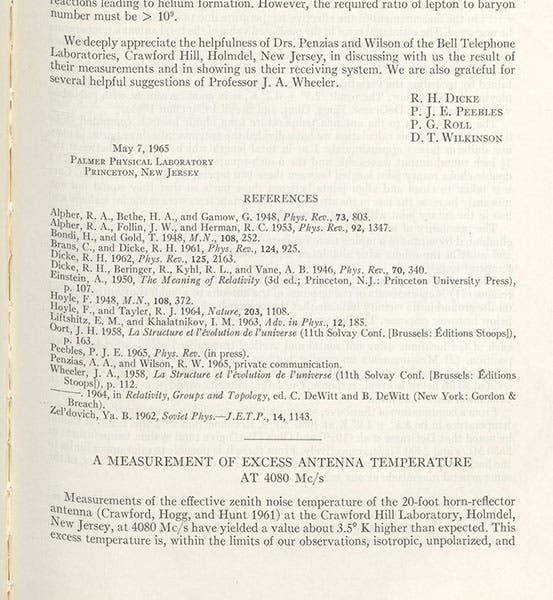
Last page of paper by Robert Dicke et al, predicting a residual cosmic black-body radiation with a temperature of 3.5° K, and the beginning of a paper by Arno Penzias and Robert Wilson, announcing the detection of a cosmic background radiation with a temperature of 3.5 kelvins, Astrophysical Journal, vol. 142, 1965 (Linda Hall Library)
It is often said that Dicke was not included in the 1978 Nobel award because predictions of a cosmic background radiation had been made earlier, in 1949, by Gamow, Alpher, and Hermann, and Dicke was unaware of their papers. This may be the case, although others have pointed out that Gamow was far less precise, and far more inconsistent, in his predictions than Dicke. We will watch and listen as historians continue to argue this point.
There is an excellent discussion of the parallel work of Dicke and Penzias-Wilson in The Discoveries, by Alan Lightman (Pantheon Books, 2005), pp. 408-434, where you will also find transcriptions of the two papers.
William B. Ashworth, Jr., Consultant for the History of Science, Linda Hall Library and Associate Professor emeritus, Department of History, University of Missouri-Kansas City. Comments or corrections are welcome; please direct to ashworthw@umkc.edu.


